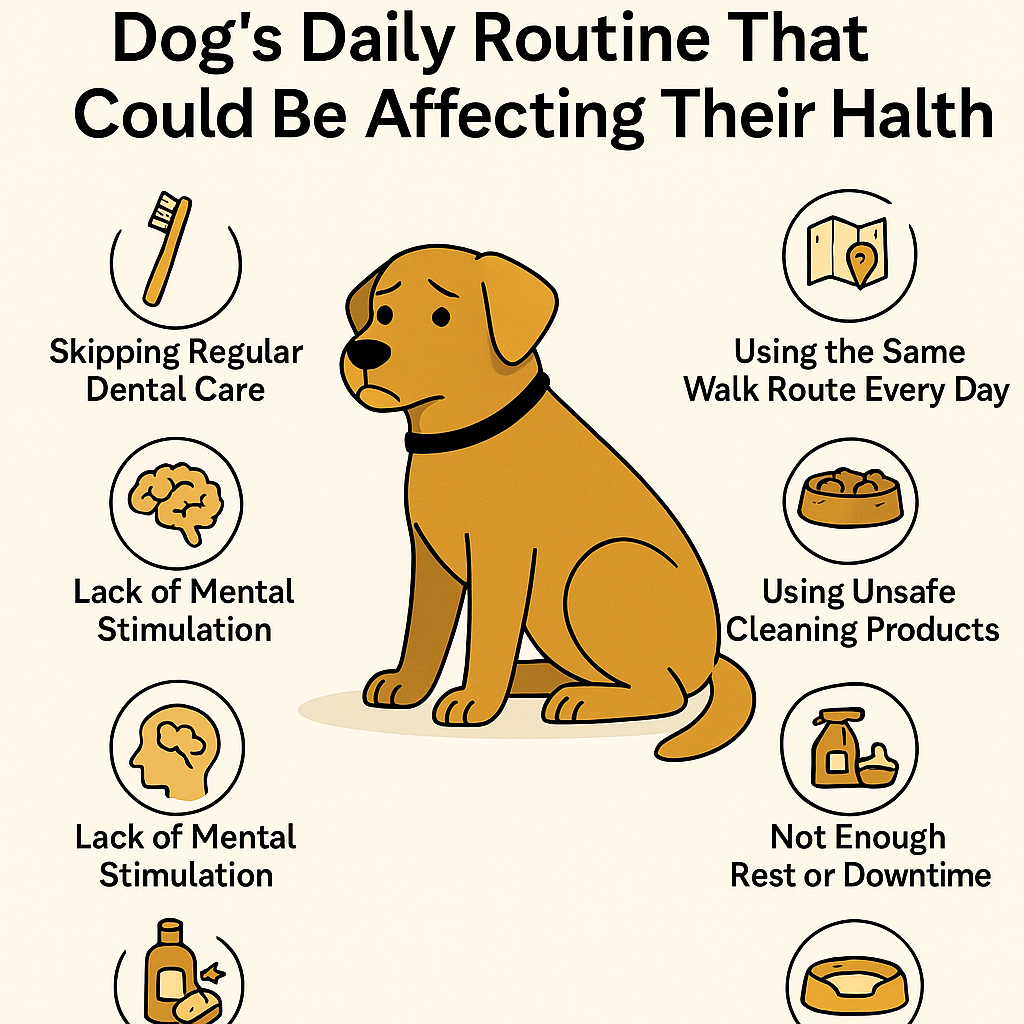
Common Dog Daily Routines That Harm Their Health
Share
Hidden Dangers in Your Dog’s Daily Routines — And How to Keep Them Safe
Dogs thrive on routine. Regular walks, feeding schedules, and playtime give them comfort and structure. But here’s the surprising truth: some daily habits that feel normal can slowly harm your dog’s health.
From unsafe toys to feeding mistakes, these risks can go unnoticed until they cause serious problems. This guide reveals the most common dangers in a dog’s daily routine and gives you easy, vet-approved fixes.
1. Feeding Table Scraps and Human Food
It’s tempting to slip your dog a bite of your meal. But many human foods are toxic to dogs. Chocolate, onions, grapes, and even certain spices can cause digestive issues or organ damage.
Why it’s risky:
- Can trigger vomiting, diarrhea, or poisoning
- Leads to unhealthy weight gain
- Encourages begging and bad table manners
Safe alternative: Stick to a balanced dog diet. If you want to give treats, choose dog-safe snacks like carrots, blueberries, or vet-approved biscuits.
2. Skipping Dental Care
A lot of owners assume dogs don’t need daily oral care. In reality, poor dental hygiene is one of the leading causes of chronic health issues in pets.
Why it’s risky:
- Plaque buildup can cause painful gum disease
- Untreated dental problems can lead to heart and kidney issues
Safe alternative: Brush your dog’s teeth daily with a dog-safe toothpaste. Use dental chews or water additives for extra protection.
3. Using the Wrong Collar or Harness
That old collar might look fine, but it could be putting stress on your dog’s neck or airway.
Why it’s risky:
- Tight collars can cause breathing problems
- Constant pressure can damage the trachea
- Ill-fitting harnesses can cause chafing or escape risks
Safe alternative: Choose a well-fitted harness that distributes pressure evenly. Check the fit regularly as your dog grows or gains weight.
4. Neglecting Mental Stimulation
Daily walks aren’t enough for a dog’s mental health. Without mental stimulation, dogs can develop anxiety and destructive habits.
Why it’s risky:
- Leads to boredom and excessive barking
- Can trigger chewing, digging, or pacing
Safe alternative: Incorporate puzzle toys, obedience training, or scent games into their daily routine.
5. Leaving Harmful Household Items Within Reach
Dogs explore with their noses and mouths. Everyday household items can be dangerous if left out.
Common hazards:
- Cleaning products
- Medications
- Electrical cords
- Small objects that can be swallowed
Safe alternative: Dog-proof your home. Store cleaning supplies and medicines in closed cabinets. Keep cords and small items out of reach.
6. Overlooking Exercise Balance
Too much exercise can strain joints, especially in puppies and senior dogs. Too little can lead to weight gain and low energy.
Why it’s risky:
- Overexercise can cause injuries
- Under-exercise can shorten lifespan
Safe alternative: Match exercise levels to your dog’s breed, age, and health. Vets can help set the right activity balance.
7. Skipping Regular Vet Visits
Some owners only visit the vet when their dog is sick. This can mean missing early signs of serious illness.
Why it’s risky:
- Preventable diseases can progress unnoticed
- Missed vaccinations put your dog at risk
Safe alternative: Schedule a wellness check at least once a year. Keep vaccinations and parasite treatments up to date.
8. Using Unsafe Grooming Products
Shampoos, sprays, or flea treatments not made for dogs can cause skin irritation or poisoning.
Why it’s risky:
- Human products may contain harmful chemicals
- Incorrect flea treatments can be toxic
Safe alternative: Always use pet-safe grooming products. Check labels for your dog’s size, age, and skin sensitivity.
Key Takeaways
- Even well-meaning routines can put your dog at risk.
- Small adjustments can protect your pet’s health long-term.
- Awareness and consistency are your best tools for prevention.
FAQs About Hidden Dangers in Dog Routines
- Q1: How do I know if a routine is harmful to my dog?
- Look for changes in behavior, appetite, or energy levels. If something feels off, consult your vet.
- Q2: Can small daily habits really harm my dog over time?
- Yes. Many health problems develop slowly, so prevention is key.
- Q3: What’s the safest treat I can give my dog?
- Plain, cooked lean meat or fresh veggies like carrots and cucumbers are good options.
- Q4: How often should I check my home for hazards?
- Do a quick check weekly and a deep safety check every few months.
- Q5: Are all human foods bad for dogs?
- Not all, but many are. Always confirm safety before giving your dog human food.
- Q6: How much mental stimulation does my dog need daily?
- At least 15–30 minutes of mentally engaging activities like puzzle toys or training games.
- Q7: What’s the most overlooked danger in daily dog care?
- Poor dental hygiene. Many owners skip it, leading to serious health problems later.